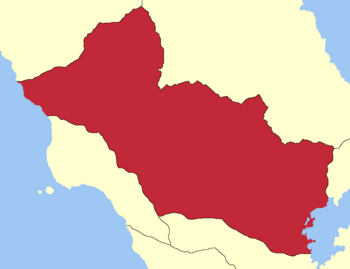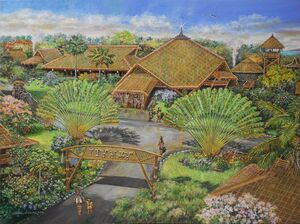United Federation
United Federation 5 other official names
| |||||||||||
|---|---|---|---|---|---|---|---|---|---|---|---|
|
Flag | |||||||||||
| Motto: Perpaduan adalah kekuatan, kebebasan adalah kedamaian (Old Namyanon) "Unity is strength, liberty is peace" | |||||||||||
| Anthem: "Call of the Republic" | |||||||||||
 | |||||||||||
| Capital | Salurong (executive and legislative) Tanpusqo (judicial) | ||||||||||
| Largest city | Bagumbiringan | ||||||||||
| Official languages | Zahalny-Yazk Lyulijka Namyanon Tagapa Qhicha | ||||||||||
| Demonym(s) | Makodyan | ||||||||||
| Government | Federal semi-presidential parliamentary republic | ||||||||||
• High Representative | Aisha Timuan | ||||||||||
• Pangulo | Nifa Nakashad | ||||||||||
| Legislature | Supreme Batasan | ||||||||||
• Upper House | Senate | ||||||||||
• Lower House | Congress of Delegates | ||||||||||
| Formation | |||||||||||
• Pre-Imperial states | 2200 BCE-1187 CE | ||||||||||
• Biak-na-Bato Confederation | 1187-1200 | ||||||||||
• Amanikaluan dynasty | 1200-1411 | ||||||||||
• Amarlangagui dynasty | 1411-1580 | ||||||||||
• Lumay dynasty | 1580-1698 | ||||||||||
• Astragonese rule | 1 May 1698 | ||||||||||
• Iterian Empire | 3 August 1802 | ||||||||||
• Fascist Makodya | 28 April 1906 | ||||||||||
• Democratization | 20 January 1997 | ||||||||||
| Area | |||||||||||
• Total land area | 1,103,712 km2 (426,146 sq mi) | ||||||||||
| Population | |||||||||||
• 2016 census | 83,048,269 | ||||||||||
• Density | 75.2/km2 (194.8/sq mi) | ||||||||||
| GDP (PPP) | 2018 estimate | ||||||||||
• Total | 2.797 trillion IBU | ||||||||||
• Per capita | 33,679 IBU | ||||||||||
| GDP (nominal) | 2018 estimate | ||||||||||
• Total | 2.153 trillion IBU | ||||||||||
• Per capita | 25,924 IBU | ||||||||||
| Gini (2020) | 34.5 medium | ||||||||||
| HDI (2020) | very high | ||||||||||
| Currency | Lale (Ł) | ||||||||||
| Time zone | SET +2 to +4 | ||||||||||
| Date format | dd.yyyy.mm dd/yyyy/mm | ||||||||||
| Driving side | right | ||||||||||
| Internet TLD | .mkd | ||||||||||
The United Federation of Iteria, commonly known as the United Federation (U.F. or UF), or Makodya, is a sovereign state stretching across from East Iteria to Central Iteria. Bounded to the west by the Meterran Sea and its northeastern frontier traces the Sunka River. It consists of 10 constituent states. Most of its 83 million citizens live in the plains. Their population centers are situated in valleys, plains, and river and lake basins. The rest of the population is spread out up in mountainous areas across 1,103,712km2 of Makodyan territory.
During the Pre-Imperial period, various enatic kingdoms and slave-trading city-states existed. Many were tributaries of the Argent Imperium until its collapse in 1187. In 1200, they formed the Tawilisi Empire. They expanded into Central Iteria and conquered Lyulijka and Qhicha states, including Astragonese territories. By the 16th Century, the Tawilisi Empire spanned far north to Craviter with colonies in modern Korova. Following the Shaddanic Wars, the Tawilisi Empire was dissolved. The client states of Makopa and Dyanatsia were formed. Astragonese rule lasted until 1802 when Prince Mamuwalde proclaimed the Iterian Empire.
Advised by exiled Astragonese reformists, Mamuwalde put the Iterian Empire in rapid transformation. Industrialization and agricultural reform led to prosperity. A cultural enlightenment that followed ended feudal values, notably the abolition of slavery and the caste system. In 1826, Mamuwalde established the Supreme Batasan—The oldest democratic institution in the United Federation.
1906 was the beginning of "Fascist Makodya" ruled by Thassad Nabantuwe with the Bagong Lipunan Party. Bagong Lipunan imposed totalitarian rule and suppressed all forms of opposition. After a 1921 coup, they abolished the monarchy to establish a military dictatorship. They banned religion, subsidized economic modernization, provided state support for scientific racialism, and legislated the Yamanglahi Laws. Yamanglahi was a series of eugenics policies that targeted "undesirables." Bagong Lipunan considered the Hailakaid peoples the most superior human race. Hailakurash (ሓኢላኩራሽ, lit. Hailakaid supremacy) was an attempt to establish a pure Hailakaid race by assimilating other cultures through interbreeding.
Bagong Lipunan was overthrown in the 1980 People Power Revolution. Although the eugenics policies were abolished, a system of minority rule was established. Fabricated justification on the population's lack of education in democratic process hid strong racist tendencies that persisted thanks to years of scientific racialism. Minority rule disenfranchised the majority population until its end in 1997. The restoration of majority rule established a liberal democracy under the United Federation.
Etymology and official name
According to the UF Constitution, "United Federation of Iteria" is the official name. There is also an official name in each of the country's 5 official languages. Short form names commonly used are the "United Federation," "U.F.," and "UF." "Makodya" is used as an alternative term in reference to the United Federation. It is a portmanteau of "Makopa" and "Dyanatsia", client states of the Astragonese Empire. These were artificial nations created from conquered territories of the former Tawilisi Empire. It existed from 1698 until 1802, when the Iterian Empire was established.
"United States of Iteria" (USI) was the favored name next to United Federation. It was preferred because it was shorter. Two bills were proposed to change the country's official name, one in 2007 and one in 2011. Any support for the name died in 2010 when West Zhen dictator, Emperor Kaihuang, proclaimed the United States of South Iteria (USSI) in the Zhen Civil War.
The term "Iteria" has never been standard. Its use has been mostly in isolated instances. According to a 2019 survey, 9 out of 10 Makodyans know the name Iteria refers to the continent. The term "Makodya" was actually created by the government during the Iterian Empire in 1857 to strengthen national unity. Prior to that, people used the demonyms of their home states (i.e. Namyanon, Druznian/Drusinon, etc.). During Bagong Lipunan rule, the term "republic" became popular in local political discourse and remains in use to this day.
In Prydanian, Makodya is called "Lawsfjöll" or "law mountains." The meaning has been obscure, but it has been argued it refers to Fascist Makodya's totalitarianism. Whether it was praise or criticism, it was not clear. In Santonian, Makodya is called "Macopa." The name originated from when Saintonian and Makodyan trade relations heightened in the 18th century. During Shaddanic rule, the Viceroyalty of Makopa, an Astragonese client state, controlled Makodya's only coast and, therefore, all of its ports.
History
Early Pre-Imperial (Pre-200)
Evidence of the first humans in Makodya were dated 500,000 years ago in lands now known as eastern United Federation near Lake Barētdelan. Remains of an extinct human pygmy species, Homo tagapanensis, were found in Kalaw Cave. This species is believed to have lived up until their extinction 50,000 to 67,000 years ago. But the oldest modern human remains were found in the Tabon Caves of Lipuun Point, dated to 16,000-18,000 years ago. In the cave complex, archeologists found pottery, jade jewelry, and stone tools. Animal bones found in intricately-designed burial jars were dated 17,000 years old. Signs of near continuous habitation in the caves even indicate they have been there since 10,000 years ago.
In the plains surrounding Lake Barētdelan, the first signs of civilization have been dated to 2,000 years ago. The Lyulijka, descendants of the Ano'an and Sinnitic migration, settled near the lake. Excavated sites in the Makodyan east revealed tools and jewelry made out of bones and precious stones. The cultural behavior of the early Makodyans exhibited communal living and warlike tendencies, before a transition to a pacifistic lifestyle. They eventually learned how to cultivate the land, domesticate animals, and founded settlements towards the 1st Century CE. Most of them returned to nomadism roaming the mountain river valleys of mideastern United Federation. Although most became sedentary, many still preferred nomadic herding. These mountain nomads would later become the Qhicha people.
Ano'an and Sinnitic migration continued throughout Iteria and eventually arrived in western United Federation. There, they encountered descendants of the Hailakaid migration from 7,000 years earlier. They spoke a lost non-standard form of Ubgandian with little evidence on copperplate inscriptions. The Ano'ans and Sinnitics assimilated with the Hailakaid population resulting into the modern Tagapa people. Influenced by neighboring early Astragonese society, the Tagapa people lived as hunter-gatherers organized into warrior tribal confederations. Matriarchal and religious traits of pre-Zhen Riko people were inherited by the new Tagapa culture. Lumanbarangay, a proto-caste feudalistic system, relied on a trifunctional stratification based on three castes: Priestesses, warriors, and commoners. Leadership depended on an elite priesthood ruled by feudal matriarchal clans. Like Riko priestesses, they led shamanistic worship to nature spirits. The unique difference was Tagapanon priestesses regularly offered blood sacrifices. Criminals and kidnapped, unwanted individuals were also sacrificed. Warrior clans, though also enatic, relied on male commanders. They helped the priesthood control warriors, who were mostly men. Warriors were also used as extra labor to quicken construction of village defenses and improvements.
Rice was introduced by Skandan traders in 1500 BCE. Most commoners became farmers, tending in rice fields and served at the pleasure of the priesthood and warrior castes. The rice culture reached Eastern Makodya by 1350 BCE.
By 1000 BCE, the inhabitants of Makodya developed warring hunter-gatherer tribes, mountain valley plutocracies, and littoral principalities.
In 20 AD, the Argent Imperium launched a year-long invasion of Makodya from Mansani. Resistance was fierce from Tagapanon tribes. After six months, they were driven out of Druznia (The present-day Drusinas). Many captured Tagapanon commoners were enslaved by the new Argent rulers. The Tagapanon living in the fortified settlements of Maasin and Bagiw negotiated conditional surrender for peace. In return, they became vassal states of the Argent Imperium. Szlavic settlers founded most of the settlements in the newly-conquered territory. Szlavication followed, enforced by the imposition of Argent law and language on the Druznian Tagapanon people. The native elite were pressured to enter intermarriages with Argent leaders. With steady migration of Argent people into Druznia, the Druznian Tagapanon were assimilated and became a minority in their own land.
In the late 1st Century CE, the Argent built an intricate network of stone roads and bridges to improve communication and movement between settlements. The Druznian Tagapanon tribal leadership joined the new urban oligarchy and participated in the Argent rule of Druznia. To encourage more settlers, the Argent offered free land to retiring soldiers. It helped populate tracts of uncultivated land abandoned by the post-invasion exodus of Tagapanon people. Argent settlements built aqueducts, temples, and schools. Larger settlements had stadiums, race courses, and amphitheaters. Despite easy assimilation of the urban areas, the rural elite persisted—particularly the Druznian Tagapanon.
Increased Argent migration led to the decline of smallholding as richer migrants bought lands to form larger holdings. Most of Druznia's new migrants would end up as tenants of these estates. The mass slave trade of other enslaved populations from other parts of the Argent Imperium were brought into Druznia. It introduced Makodya to the global slave market.
Late Pre-Imperial (200-1200)
By the 7th Century CE, the coastal settlements have emerged as trade centers. In 592 CE, Syrixian traders arrived in the Makodyan coast. They travelled with scholars and Rakani priests. This marked the beginning of the Tagapa renaissance, when Tagapanon society acquired from foreigners various cultural characteristics to form the basis of modern Tagapanon culture. The first phase of the renaissance involved the "samrajicization" of Old Tagapanon culture. The modern Tagapa language and writing system was derived from Suchari. The fusion of Rakanism with pre-existing Tagapanon folk religions and animist beliefs led to the creation of Diwanism.
The first Samrajinized kingdoms naturally emerged in the Makodyan coast. They later expanded inward and gave rise to new kingdoms in the bountiful plains of Western United Federation. There were also Tagapanon tribes that were either aided or conquered by Syrixian warriors who led inland conquests. A confederation of Tagapanon tribes in the coast formed the Ataganon Kingdom in 653 CE. They were led by a diarchy of elected tribal queens (datus perkowinan) and hereditary priestesses (babaylan). The adoption of Syrixian influences for law and custom fostered the earliest forms of the imperial cult. Like Syrixian emperors, Tagapanon datus and priestesses were perceived as semi-divine. Upon death, they become deities themselves and their ancestral homes were considered holy ground. Syrixian law, arts, and science continued to impress Tagapanon elite. Syrixian and Rakanist practices spread throughout Tagapanon culture.
The modern Tagapanon caste system took much of its rigid shape in 8th century Ataganon. In 769, Datu Puti of the Ataganon Kingdom said the caste system was founded on the belief that "all people were divided into a one and true defined hierarchy of work and duty." Commoners, slaves, and indentured servants were called "alipin." Merchants were called "bashas." Scholars and leaders in philosophical and legal subjects such as datus and priestesses were called "maginoo." This hierarchy of castes were maintained righteously by "timawa," the warrior caste.
It did not take long before Syrixian influences were brought to Qhicha and Lyuli cultures. Several Suchari loanwords and influences could be observed in the Lyuli language. New farming techniques allowed the Qhicha people to cultivate rougher terrain in the foothills of both Pukaranras and Chumpas mountain ranges. The Qhicha highland plutocracies prospered, but because of their limited fertile and habitable land, the population was very urbanized.
The once nomadic Qhicha people travelled in families. As a result, they became communal. The Qhicha kingdoms were built on a stratified, meritocratic, but collectivist class system inspired by the Astragonese castes. All of the lands in a kingdom belonged to the king or "inka" (ruler). The inka distributes the land to three estates: the imperial church, the commoners, and the state. Distribution of land were based on their needs and mutual benefit. The brightest members of the community became its leaders while the rest were expected to contribute to the needs of society. This meant commoners, the bulk of labor, had to be versatile in skills. Labor and resources were centralized, equally re-distributed according to the people's needs. But equality only existed between members of the same class.
Lyuli towns surrounding Lake Barētdelan grew into thalassocratic principalities. They traded with neighboring Alnaria, Lorbank, and Zhen. In constrast to Qhicha lands, the Lyuli people lived on flat lands. Vast farmable lands and abundant resources were available to their development. Pre-Imperial Lyuli settlements had advanced urban planning. Its common layout featured brick housing, public baths, and a complex canal system for sewage and flood control. But Lyuli settlements were not like the great cities found in neighboring lands, including Qhicha. Due to their nomadic nature, the Lyuli earned their reputation as travelling merchants and the Lyuli homeland became an important region for intercontinental trade. Increased trade activities required repositories of transactions and agreements spread across Lyuli. These centers where they exchanged and stored knowledge were the first libraries in Makodya. Lyuli temples also served as repositories and educated local children. This spurred the early development of the arts and sciences in Makodya. Out of all the Pre-Imperial civilizations, the Lyuli were the most advanced.
Government and politics
The form of government is a semi-presidential, parliamentary democracy based on the Goyanean model. The High Representative of the United Federation is the head of state. The President of the Executive Council, or Pangulo, is the head of government. The High Representative is elected by popular vote every four years with two term limits. The Pangulo is elected by parliament every four years and has no term limits. The Pangulo also serves as the deputy of the High Representative and is first in-line in the executive succession. The current High Representative is Aisha Timuan of the Katipunan Party—The ruling party. Nifa Nakashad is Pangulo, also from Katipunan Party. The Pangulo, as head of government, appoints the Cabinet and other executive officials. The High Representative fulfills a more ceremonial role, albeit with a few special roles as head of state, empowered with emergency powers in crises. Most of the High Representative's duties are concentrated in his role as chief architect of UF foreign policy. However, powers of the High Representative and the Pangulo can also be defined by parliament. Under the current government, both are perceived as co-leaders of the country.
Legislatures in the local, state, and federal levels are sources of the nation's laws. All local and state legislative bodies are independent and equal, subject only to the Supreme Batasan, the federal legislature. The Supreme Batasan is a bicameral body that comprises of the Senate and the House of Delegates. The federation is organized into constituent states, federal territories, and local government units. All three territories have a form of legislative and executive government. Only the constituent states have an individual judiciary, subordinate to the UF Court of Justice. The tripartite separation of powers only exist in the federal government. All members of the legislative and executive branches are elected. The judiciary branch is independent and appointed by the Judicial Independence Commission. Its standardized selection of judges are based on their ability as jurists regardless of their political associations.
Demographics
Languages
| Language | Speakers | ||
|---|---|---|---|
| Tagapa | 36.92 % | 30,665,089 | |
| Qhicha | 24.70 % | 20,512,453 | |
| Lyulijka | 17.79 % | 14,773,536 | |
| Namyanon | 7.31 % | 6,074,655 | |
| Zahalny-Yazk | 4.39 % | 3,645,660 | |
| Other foreign languages/(local) dialects | 8.83 % | 7,336,534 | |
| Not reported/not stated | 0.05 % | 40,342 | |
| TOTAL | 83,048,269 | ||
| Source: UF Census Bureau, 2016 | |||
The five official and national languages of the United Federation are Zahalny-Yazk, Lyulijka, Namyanon, Tagapa, and Qhicha. In addition, there are 13 local individual dialects. There used to be eight other official languages but they have been determined extinct upon the ratification of the 1997 UF Constitution. Provided in the Constitution are also the language regulators of Tagapa and Qhicha. They formulate rules, officiate new words, and enforce the standardization of both languages. For Tagapa, the language regulator is the Institut ng Wikang Tagapa (Institute of the Tagapa Language). For Qhicha, it is the Quraq Suntur Qhicha Simi (High Academy of the Qhicha Language).
Tagapa and Qhicha are the primary languages of the country. Historically, Tagapa has been the sole administrative language. Under Fascist Makodya, it was reinforced due to the Yamanglahi Laws, which banned the use of other languages. Qhicha and other languages returned to government use after the 1980 People Power Revolution. Both Tagapa and Qhicha languages are used in government, education, print, broadcast media, and business, usually with a third local language or dialect. Constituent states have recognized and promoted the use of local languages and dialects. Mercanti has been promoted for use in the private sector and urban areas due to globalization. The Hailesha language, though it lost its official status in 1997, is used by the elite. Hailesha has been strongly associated with the old rich. The nouveau riche is stereotypically identified with Mercanti. Religious languages such as Rafhani and Yiddish are taught, respectively, in Mehrabist and Shaddaist schools.
Astragonese Makodyans speak dialects from their province of origin. These dialects are Bhadari, Na Themba, and Neo Hailasse. The North Bhadari Autonomous Region in Qulla officially uses North Bhadari, also an Hailesha dialect. Mansini Makodyans also speak the Astragonese languages as well as the Mansini languages such as Wursuufan, Sanulama, and Fussian.
The UF Constitution mandated the Tagapa Sign Language as the official sign language of the United Federation to be used as a medium of communication and instruction with the deaf and their education.
Culture
National anthem
Voice of Iteria, also known as the Call of the Republic, is the national anthem of the United Federation. The song was written and composed by Koja Naketa, a Messianist preacher, for the 1902 Makodyan Centennial Celebrations. It became associated with Pan-Iterianist and civil rights movements in the late 1920s and early 1980s. There was no official anthem and another song, Bayan Ko, was alternatively used. Despite its early use, Voice of Iteria has been the popular choice for a national song in public events under Fascist Makodya. But new lyrics were written in 1922 by Col. Biko Bawale, Head of the Barongan (Fascist Makodya secret police). Unlike the original, the new lyrics was only sung in Tagapa. The 1902 lyrics was restored when the song was finally adopted in 1997 when the UF Constitution was formally ratified. It is sung in all the five official languages.
Ringing out from our blue heavens, |
In our body and our spirit, |
Former imperial anthem
Hail Makodya is a Makodyan patriotic song and former national anthem of the Iterian Empire (1809-1906). It was part of a nationwide campaign to introduce the empire's alternative name "Makodya." The name was recycled and was formerly used by foreigners as a short form reference to the former Astragonese client states "Makopa" and "Dyanatsia." The song was written and composed in 1807 by Astragonese exile Kapia Na Nyala, Makodyan stateswoman and poet. She was commissioned to write the anthem by Chancellor Mayowa Kilayko, the first Makodyan to be elected head of government.
Hail Makodya, happy land!
Hail, ye heroes, slave-born band,
Who fought and bled in freedom's cause,
Who fought and bled in freedom's cause.
And when the storm of war was gone
Enjoy'd the peace your valor won.
Let independence be our boast,
Ever mindful what it cost;
Ever grateful for the prize,
Let its altar reach the skies.
Chorus
Firm, united let us be,
Rallying round our liberty,
As a band of brothers joined,
Peace and safety we shall find.
Immortal patriots, rise once more,
Defend your rights, defend your shore!
Let no rude foe, with impious hand,
Let no rude foe, with impious hand.
Invade the shrine where sacred lies
Of toil and blood, the well-earned prize,
While off'ring peace, sincere and just,
In Heaven's we place a manly trust,
That truth and justice will prevail,
And every scheme of bondage fail.
Chorus
Firm, united let us be,
Rallying round our liberty,
As a band of brothers joined,
Peace and safety we shall find.
Behold the Emp'ror who now commands,
Once more to serve his country stands.
The rock on which the storm will break,
The rock on which the storm will break.
But armed in virtue, firm and true,
His hopes are fixed on Heav'n and you.
When hope was sinking in dismay,
When glooms obscured Makodya's day,
His steady mind, from changes free,
Resolved on death or liberty.
Chorus
Firm, united let us be,
Rallying round our liberty,
As a band of brothers joined,
Peace and safety we shall find.










